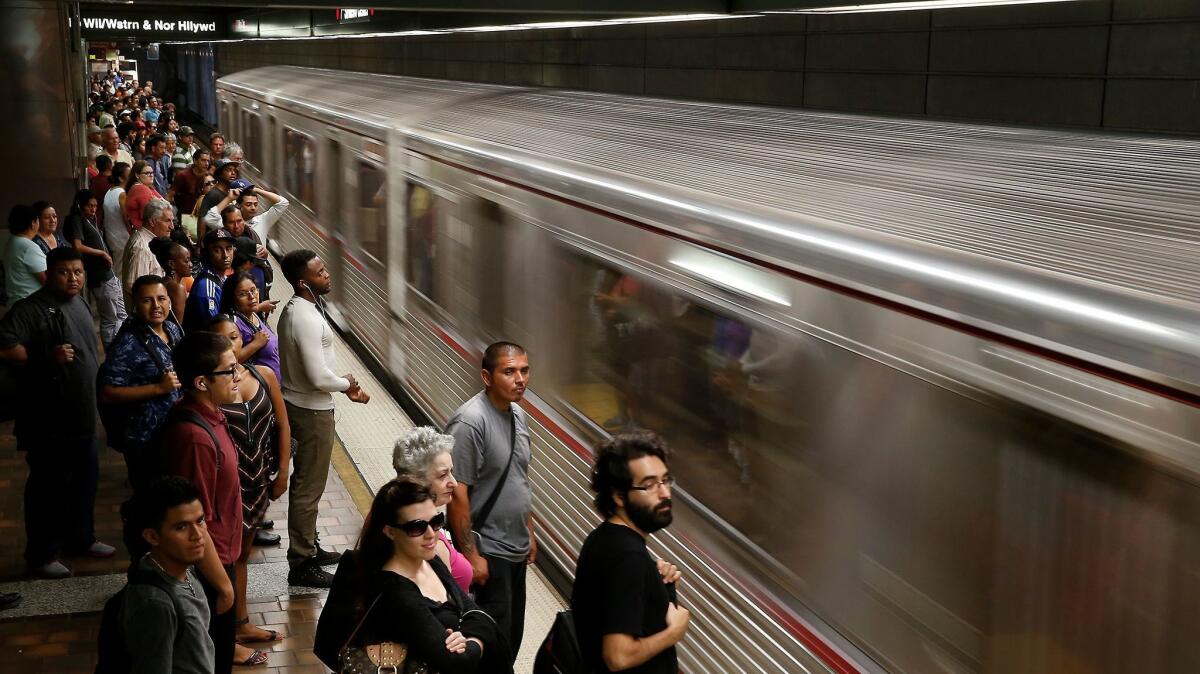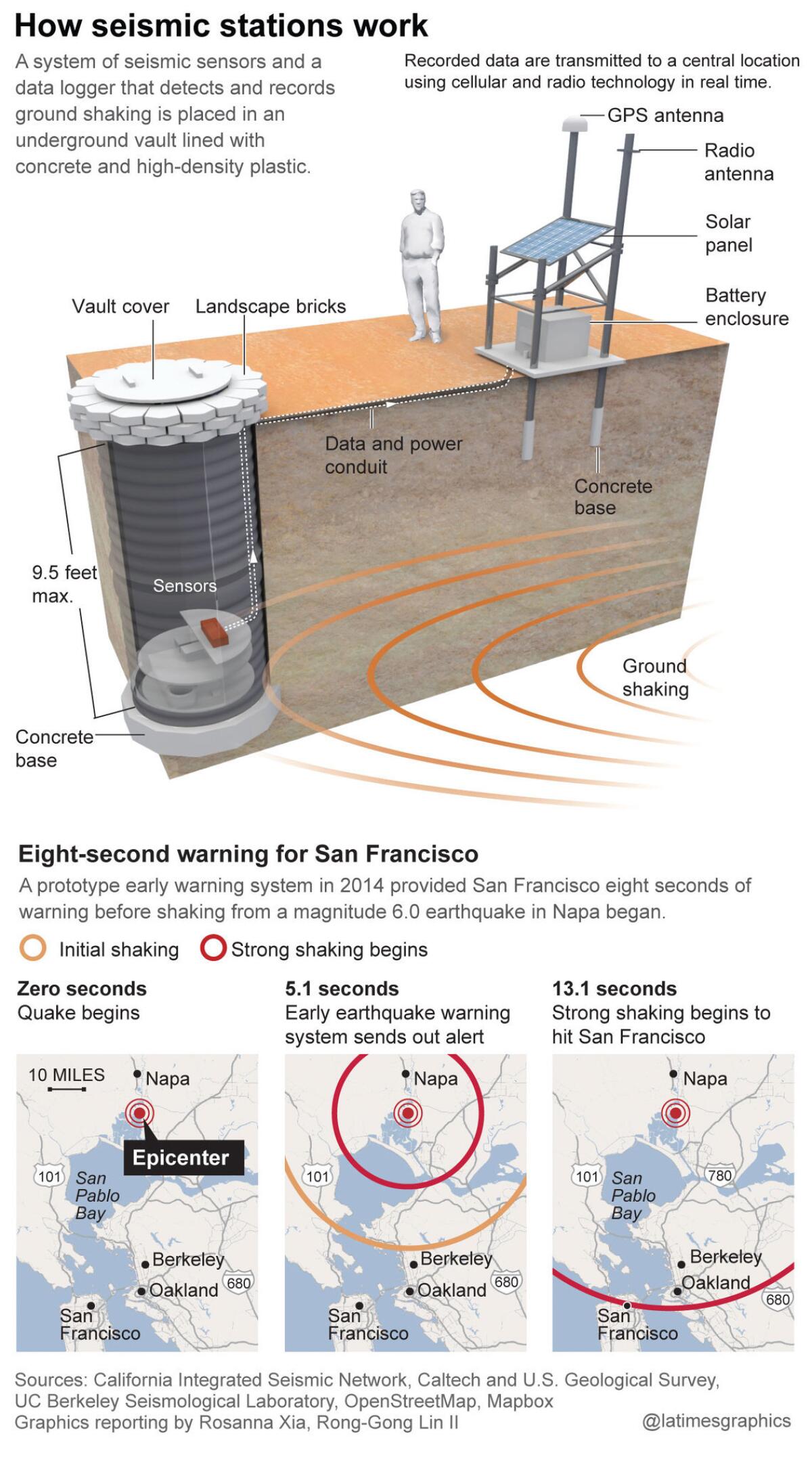From elevators to trains, earthquake early warning system grows as Trump threatens to kill it

Seismologist Lucy Jones, joined by Rep. Adam Schiff (D-Burbank), demonstrates how an earthquake early warning system could give Los Angeles a minute to prepare before strong shaking arrives.
While the future of the West Coast’s earthquake early warning system is in peril from
A scattering of buildings are now equipped with audible alarms that will give occupants an advance warning ranging from seconds to more than a minute before the shaking from a major earthquake begins.
There are even buildings wired to prevent people from being trapped in elevators after an earthquake. The system is set up to trigger elevators to stop at the nearest floor for occupants to escape as an announcement is simultaneously broadcast: “Earthquake! Earthquake! Earthquake! Drop, cover and hold on!”
Facilities of all types are testing the software in conjunction with the U.S. Geological Survey, including airports, hospitals, oil refineries, pipelines, schools and universities, said Josh Bashioum, founder of Early Warning Labs, a company in Santa Monica developing technology to pipe USGS warnings into buildings.
Alerts from desk phones
At Santa Monica College, Internet-connected desk phones of a group of trained workers will suddenly transform into speakers warning of an imminent earthquake, Bashioum said.
Universal sets up radio alert system
The radio system at Universal Studios and Universal City’s fire station is programmed to alert critical staff of expected shaking and allow firefighters to open garage doors before a possible power outage makes them inoperable, Bashioum said.
Condominiums with seismic alerts
A luxury 19-story condominium tower in Marina del Rey, the Regatta Seaside, is wired to warn residents through an existing public address system tied to the smoke alarms.
“I am so stoked,” said Robert Sides, general manager of the building’s homeowners association. “You can save lives.”
Stopping Metro trains
In its most aggressive expansion yet, the Los Angeles County Metropolitan Transportation Agency is now receiving earthquake early warnings through its rail operation control center’s public address system.
Controllers are trained to “notify all train operators to stop their train movement because a pending earthquake is upon us,” reducing the threat of a derailment, said Aldon Bordenave Jr., Metro’s manager of emergency and homeland security.

Shutting down pipelines
In the oil and gas industry, a few seconds’ warning may be enough to have crews manually shut down certain pipelines pumping fuel at high pressure — or to do so automatically — and therefore avoid uncontrollable geysers of petroleum products spilling from a broken pipe and posing an explosive hazard, Bashioum said.
Telling the surgeon to remove the scalpel
Hospitals, Bashioum said, are testing visual notifications that can signal to operating room staff that an earthquake is coming so surgeons can remove their scalpels and shut off electric cauterizers to prevent fires. Hospitals could even shut down coolant systems, which if broken during a quake could release toxic chemicals throughout the building.
L.A.’s plan to roll out early warnings next year
The progress comes a year ahead of the USGS timetable for a limited public release of the early warning system. In April, Los Angeles Mayor
What an earthquake early warning alert could look like on a cellphone. Source: Early Warning Labs
The threat of Trump’s budget proposal
Yet the rapid progress could all unravel if President Trump’s budget is approved. The Department of the Interior is proposing no funding for the system this year and “would end USGS efforts to implement the ShakeAlert earthquake early warning system, suspending internal efforts and eliminating external funding to partners” such as Caltech, UC Berkeley, the University of Oregon and the University of Washington.
Seismologist Lucy Jones, who formerly worked for the USGS, said she imagines that such a decision would cripple the ShakeAlert program.
Ending federal involvement in the system would prompt scientists to leave the project, Jones said. The early warning program needs dozens of researchers continually improving the software, monitoring and operating the system, and installing and repairing seismic sensors, she said.
‘We are on the cusp of it really making a difference’
“We are on the cusp of it really making a difference here in Southern California,” Jones said in an interview. Without the USGS’ leadership, “it would have to start over from a very basic level.”
The U.S. is years behind Japan, Mexico and other nations
The USGS and its partner universities have spent years developing the system. Other nations, including Japan, Mexico, Taiwan and Turkey, already have operational systems. In Japan, the early warnings are a part of life — schoolchildren are trained to drop, cover and hold on when they are hear alerts; TV shows are interrupted by a familiar chime and an announcer who provides details of the expected shaking; and cellphones automatically broadcast audible alerts.
Officials described the proposed $10.2-million cut to the Interior Department budget as “sensible and rational reductions and making hard choices to reach a balanced budget by 2027.” Overall, Trump’s budget boosted defense spending and made cuts elsewhere.
How the early warning system works
The earthquake early warning system works on a simple principle: The shaking from an earthquake travels at the speed of sound through rock — slower than the speed of today’s communications systems. For example, it would take more than a minute for a magnitude 7.8 earthquake that started at the Salton Sea to shake up Los Angeles, 150 miles away, traveling along the state’s longest fault, the San Andreas.
The system needs $38.3 million to be fully built out and $16.5 million a year to operate and maintain it, according to estimates. The federal government has already invested $23 million in the system; California lawmakers and Gov. Jerry Brown last year approved $10 million. Los Angeles has also directed money for the installation of seismic sensors in Southern California, Jones said.
Crucial federal funding is in doubt
“If we take out that center pin of the USGS funding, the investment of everybody else also goes to naught,” Jones told reporters at a news conference Thursday at Caltech.
Jones added that the nation would benefit if the West Coast is better prepared for earthquakes. The nation’s two busiest ports — Los Angeles and Long Beach — together handle about 40% of the country’s imports arriving in containers. “Their paths out to the rest of the country have to cross the San Andreas fault to get to everybody else,” Jones said.
Rep.
Congressional funding for earthquake early warning
- 2015: $5 million
- 2016: $8.2 million
- 2017: $10.2 million
“The White House decision to eliminate support is incredibly misguided and dangerous, and undercuts the $23 million already invested in the program,” Schiff said at the news conference.
Schiff sounded hopeful that Congress would reverse Trump’s proposal. Rep.
One of California’s most dangerous faults, the San Jacinto fault, lies under Calvert’s congressional district. Scientists say the San Jacinto fault is capable of moving together with the San Andreas and producing a magnitude 7.5 earthquake.
Schiff and Jones expressed hope the system would become active before the next big earthquake.
“When you look around the world, these systems have been established after a lot of people died in a big earthquake,” Jones said, ticking off several examples:
- Mexico lost 10,000 people in 1985.
- Japan lost 5,000 people in 1995.
- Turkey lost 17,000 people in 1999.
- And China lost 80,000 people in 2008.
“Each of those then triggered the development of an early warning system in those countries,” Jones said. “It’ll be a shame if we only get it because we kill a lot of people.”

Sign up for Essential California
The most important California stories and recommendations in your inbox every morning.
You may occasionally receive promotional content from the Los Angeles Times.








